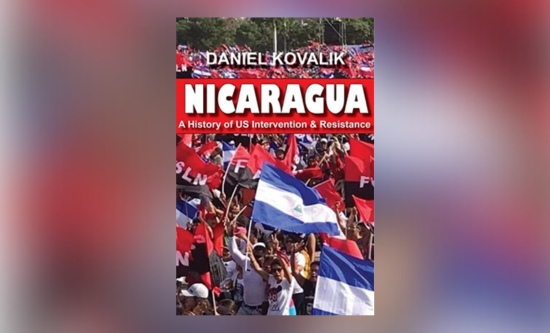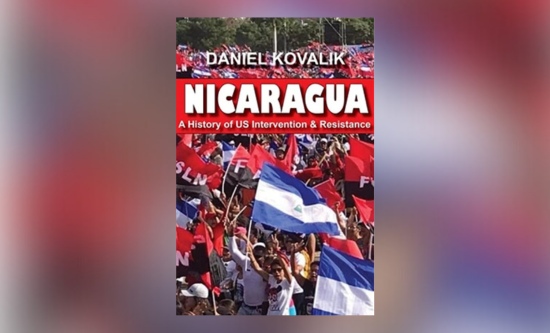
Nicaragua: a history of US intervention and resistance, Daniel Kovalik, Clarity Press 2022, £21.99 hbk
One of the joys of reviewing books for a communist newspaper is that from time to time, a veritable breath of fresh air falls into your lap. Such is the case with Nicaragua: a history of US intervention and resistance by Daniel Kovalik. This is quite clearly a labour of love, the fruit of numerous visits to Nicaragua and over three decades of work in solidarity with it, starting at the height of the US-backed Contra war in 1987.
Kovalik talks us through almost two centuries of Nicaraguan history, from the first attempts to assert its independence in the 19th century and into the 20th, through the struggle led by Agosto Cesar Sandino in the 1920s and 1930s against the US occupiers and the murderous Somoza dynasty, where he quotes President Roosevelt’s endorsement in 1939 of the dynasty’s founder: ‘Somoza may be a son of a bitch, but he’s our son of a bitch’ (p47). He continues through the resumption of the armed struggle led by the Sandinista national liberation front (FSLN), the triumph of the revolution in 1979, the mercenary Contra war of the 1980s and the depredations of the US puppet regimes in power between 1990 and 2006. We come then to the re-election of the Sandinistas in 2006 and the renewed US attempts to overthrow them, culminating in the attempted coup of April-July 2018. At every stage of this struggle, Kovalik makes clear that there is a common thread: ‘The interference of the Yankee colossus, which is determined to destroy what Oxfam in a 1985 pamphlet by Dianna Melrose called “the threat of a good example”‘.
Kovalik points to a curious paradox. It is the latest stage of the struggle – the one inaugurated by the election of the Sandinistas in 2006 and their re-election three times since, bringing with it the reinstatement of health, education and land reform programmes in the face of unremitting US hostility – that is the least understood in the US and other imperialist countries. How is this possible? Obviously, US media disinformation, portraying the US-organised attempted putsch in 2018 as a peaceful movement brutally suppressed by the evil Sandinistas, especially their Secretary General and President of Nicaragua, Daniel Ortega – plays a crucial role, as ever. Yet this campaign might not have succeeded without the aid of a layer of petit bourgeois pseudo-leftists, many of whom were vocally pro-Sandinista in the 1980s but who have now forgotten all they ever knew about imperialism, cheering the US-backed putschists and echoing their denunciations of Ortega as a new Somoza. Kovalik is scathing about these people: ‘We see such hypnosis [by the US media] operational today in the case of Nicaragua, with many people who once defended Nicaragua against US attacks, and who had even visited Nicaragua during the US-backed Contra war of the 1980s, applauding current US sanctions against the country as a means to somehow punish Daniel Ortega – a leader they once admired, but who them are now convinced is npthing more or less than a petty dictator. Again, it is as if such people had forgotten their own experiences and what their eyes have seen and their ears have heard, so powerful is the assault upon their senses and memory by the propaganda machine’ (p14-15).
As to the class forces actually involved in the 2018 putsch, Kovalik is clear, and in meticulous detail. He identifies the putschists’ main financial backers as two US government agencies, the National Endowment for Democracy (NED) and the US Agency for International Development (USAID). Internally, their main tools were the bosses’ outfit, the Supreme Council of Private Enterprises (COSEP) and the Catholic Church hierarchy. As to the latter, Kovalik goes into extensive and shocking detail. Churches were regularly used as headquarters by the putschists, and in some cases as places where Sandinista militants were tortured. Bishops publicly called for the assassination of Daniel Ortega and his family (pp232-33).
No listing of the putschists would be complete without the so-called Sandinista Renovation Movement (MRS), a 1994 split from the Sandinistas by the party’s most right-wing and pro-capitalist elements, led by former vice-president Sergio Ramirez. By 2006, this outfit had plumbed the depths of reaction, with its leaders acting as informers for the US Embassy:
‘In regular meetings with US officials, [Dora Maria] Tellez, Sergio Ramirez, Hugo Torres Jimenez, Victor Hugo Tinoco and other top MRS figures provided the United States with intelligence about the FSLN and internal Nicaraguan politics in an attempt to prevent the Sandinistas from returning to power’ (p226). It was in vain: the Sandinistas won the elections, with the MRS getting just 6% – although this less than impressive showing was far more than it has ever managed before or since. Kovalik’s verdict is clear: ‘it [the MRS] is anything but a progressive or revolutionary organisation. However, while approved by both the US government and most of the US left, the MRS was not even close to winning the 2006 election’ (p227, emphasis added).
The Sandinistas attempted to negotiate a peaceful settlement, but the protesters, clearly emboldened by US backing, would accept nothing short of their total capitulation. One of them, student leader Lestheir Aleman, addressed Ortega thus: ‘This is not a table of dialogue, this a table to negotiate your exit and you know it will, give up’ (p202). The Sandinistas didn’t give up. Patiently they waited for those manning the putschists’ tranques, or roadblocks, to become demoralised for want of popular support, and in the end they were able to demolish them peacefully. The far from peaceful putsch included the murder of 198 civilians and 22 police officers, and far-reaching socio-economic costs.
No words of mine could possibly do justice to Kovalik’s work, so let’s give the last word to Jose Adan Rivera Castillo, a leader of the mass Agricultural Workers Coordination. Rivera played a key role in dismantling the tranques; he now takes apart the claims of US imperialism and its pseudo-leftist tools about Daniel Ortega being a new Somoza:
‘The difference is that Somoza did not have popular support, but Daniel does… in just 15 years of government, we have been able to implement a wide range of social and economic programmes like never before. When they say Daniel is bad, that reaffirms that he is a good person for us. We would worry if the enemies of the revolution began to speak well of him’ (p180).
Viva Nicaragua libre! US hands off Nicaragua!
Mike Webber




